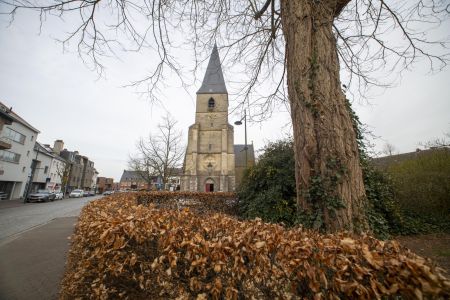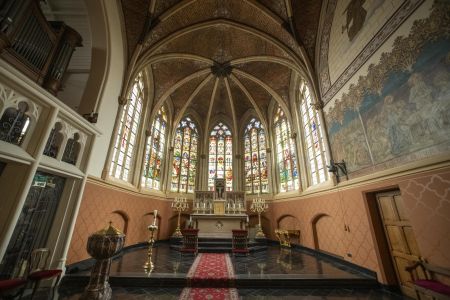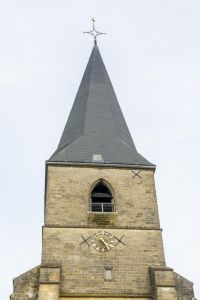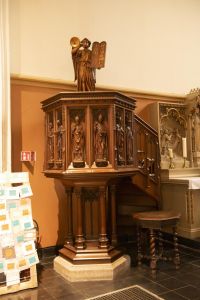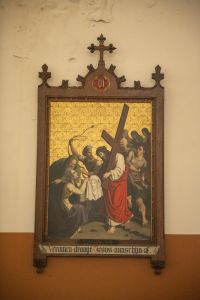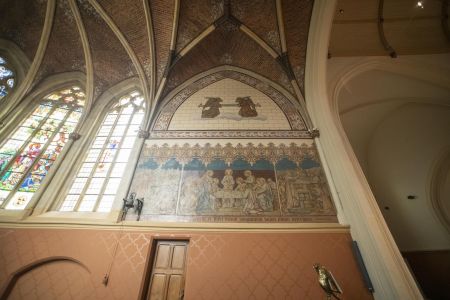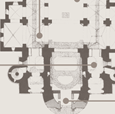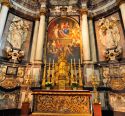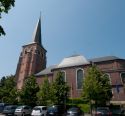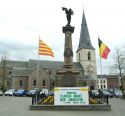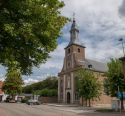Church | ca. 1600 | Gothic | Catholic Church






Map
Opening hours
01 January - 31 December
Mon 8.00 - 18.00
Tue 8.00 - 18.00
Wed 8.00 - 18.00
Thu 8.00 - 18.00
Fri 8.00 - 18.00
Sat 8.00 - 18.00
Sun 8.00 - 18.00
Portal: approx. 8 a.m.-6 p.m., depending on season
Church: only during celebrations and in cooperation with the congregation on special days such as the annual Open Monument Day
Religious offices
Description
The attached west tower (1385) has five storeys. The first and part of the second floor are made of flint, with limestone corner bands. The others are in marlstone. The portal is neo-Gothic. The tower is topped by a gabled spire and, on the south side, a four-storey polygonal stair turret.
The late Gothic nave (1600s) is built of brick. It is a cruciform church with three naves and a five-sided closed choir. Around 1900, 15th-century wall paintings were discovered, but these disappeared when neo-Gothic paintings were added in 1920.
The interior contains a unique 12th-century baptismal font, magnificent statues, notably of St. Roch, and a special calvary. Magnificent stained glass windows create a special atmosphere.
Next to the recently restored, centuries-old church is a small chapel, well-maintained throughout the year. People suffering from ailments or illnesses seek the support of Saint Aldegonde here, and have permanent access to the chapel. Celebrations of her feast day take place every year on January 30 and the following Sunday.
Sources: Wikipedia - Immaterieel erfgoed.be
KIKIRPA: Photo-library online
Photos
Remarkable elements
Maître-autel et autels latéraux
L'autel principal (1900) et les deux autels latéraux (1902) sont de style néogothique et proviennent de l'atelier Peeters d'Anvers (1900). Au centre se trouve le sacrifice de Melchisédek, à gauche Caïn et Abel et à droite David et les pains de proposition. L'autel de la nef sud est dédié à sainte Aldegondis de Maubeuge, avec des images de sa vie. Elle est la première patronne de cette église. Le vitrail contient une scène de Pentecôte. L'autel de la nef nord contient des images de Sainte Marie. Le vitrail au nord représente la naissance du Christ.
Chaire de vérité
L'homélie ou le sermon est la partie de l'Eucharistie où le prêtre interagit avec les fidèles. À l'époque où l'amplification électronique du son n'existait pas encore, la chaire était placée le mieux possible au centre de l'église, souvent contre l'un des piliers. Cette chaire (P.Peeters, 1900) est néogothique, en chêne massif, et contient une représentation des pères de l'église et des évangélistes.
Vitraux
Les 3 vitraux centraux, représentant le sacrifice et l'eucharistie, ont été réalisés dans les ateliers de Ladon à Gand. Le vitrail central a été installé en 1903, les autres en 1911 et 1913. De gauche à droite, nous voyons Le sacrifice de Caïn et Abel,
Abraham offrant son fils Isaac, Jésus rompant le pain avec les disciples d'Emmaüs, Jésus transformant l'eau en vin (Noces de Cana), Multiplication des pains.
Dans la nef de l'église, on trouve des vitraux des deux côtés représentant à chaque fois les autres saints patrons vénérés à Alken. Saint Arnold est le patron des meuniers, des aubergistes et des brasseurs. Saint Hubert de Liège est le deuxième patron de cette église et est invoqué contre la maladie d'Alzheimer.
Tour et maison du cordonnier
Au-dessus de la porte menant à la cage d'escalier, à droite, se trouve un très ancien passage. Il a été redécouvert lors de la chute d'une grande partie du plâtre en décembre 2019. L'ascension de la tour ne peut se faire qu'avec un guide. Cela demande un certain effort en raison des nombreuses marches, dont beaucoup sont très difficiles à gravir en raison de l'usure.
La première église-halle de l'« Alleke » était probablement détachée de la tour à l'endroit où se trouve actuellement une place (Laagdorp). Avant 1600, l'église-halle actuelle a été construite à côté de la tour de l'église. Les recherches montrent que le clocher a été habité par un cordonnier pendant plusieurs générations. Peut-être était-il également sacristain et sonneur de cloches.
Bénitiers
Les deux bénitiers à l'entrée sont peut-être les objets les plus anciens. Au Moyen-Âge, cette église servait d'église baptismale pour les églises environnantes de la région.



